28 Oct 2015
Q: I thought you abandoned your blog in 2013 for twitter.
I did! And I’ve felt insanely guilty about it ever since.
Recently, however, I’ve been having more conversations on twitter where the 140-character limit is, well, limiting. I’ve found it frustrating to make any kind of a complex argument across a tweet thread, even with linked conversations. Some thoughts need more room.
I’ve also wanted for some time now to get back into the habit of writing for fun. The full-time day job I had until recently was sucking up a lot of my writing energy, and I’ve done very little writing in the last bunch of years that wasn’t job-related, or 140 characters or less.
But I recently left that day job, now is as good a time as any for a full-on blog reset.
Q: What happened to blog.lauralemay.com?
Ages ago I set up my blog on a separate subdomain from my “main” site, and I can’t remember why. It seemed like a good idea at the time, maybe?
Having two different sites ended up being more annoying than I had intended. For one thing, I was trying to maintain two entirely different wordpress installs, with separate themes and plugins. (Yes, I know about WP multisite, and at the time I could not get it to work. LS;B (Long story, boring)).
With the reset I have merged everything back into www.lauralemay.com and a single wordpress install. The blog.lauralemay.com site still exists but I’m planning to put in a redirect once things here have settled down.
Q: I can’t believe you’re still using WordPress when you got so badly hacked, repeatedly, in the past. What’s wrong with you?
This is really a case of “better the devil you know.”
My original plan for a new blog had been to set up something simpler, easier to understand, and less prone to hacking problems than WordPress.
I spent a couple months earlier this year down a rabbit hole of learning all about static site generators (like Jekyll and Pelican and Hyde) for just this reason.
But the deeper into that rabbit hole I got, the more I realized how much work it was going to be to modify any static site software to output the design and structure and functionality I wanted. The time investment was going to be way more than I was willing to spend given that the actual goal was to write more, not spend more time working on software, or being my own sys admin.
WordPress has its issues, and I’ve seen a lot of them, but I understand it fairly well at this point. Also the community around themes and plugins is so rich that using WordPress gives you a huge step up in building a blog-like site versus starting everything from scratch.
Q: Yes, OK, but the hacking thing?
I figured out the hacking thing. If you put wp-login.php and the entire wp-admin directory behind access control (even dumb basic auth in .htaccess) then the hacking stops. My old blog (and my old site) have been locked down like this for three years and I have had no further issues at all. (This is not a challenge.)
Q: You don’t have comments enabled. When are you going to turn comments back on?
I’m not. I did leave the old comments in place on my old blog posts because it felt weird to just delete them. New posts do not have comments, and won’rt.
Even on a blog as little-read as this one just managing spam in the comments was a pointless time sink. Replying to and managing actual real-life comments was also a lot less fun than I had thought it would be. At best I feel like I’m not keeping up, and guilty for not engaging better. At worst there are seemingly endless numbers of blowhards who use my comments to lecture or “well-actually” me, or to argue at length about things only semi-related to my actual posts. There are plenty of places to have an opinion on the Internet. This is mine. Get your own blog.
I am easily found on twitter or email if you really want to talk to me about something I’ve written.
Q: Are you going to talk endlessly about octopus and chickens all the time like you did before?
Yes! Also food, and cooking, and gardening. No links (those go on twitter). More personal stuff. And (I hope) much shorter posts rather than the 20-page essays and the immense multipart sagas I was doing before. (This post so far is not a good start.)
You will also occasionally see a post about technical writing, which is what I do for a living and a subject I feel strongly about (Yes, I know, I am strange). I am still figuring out the right way to categorize different subjects in the same blog, so we’ll see.
Titles will be properly uppercased this time around as well.
Q: Your ideas are intriguing to me and I wish to subscribe to your newsletter.
My new RSS feed is at https://www.lauralemay.com/feed. A blog-only feed (no pictures, links, tweets or other stuff sucked in from elsewhere) is https://www.lauralemay.com/blog/feed. You can also follow me on twitter for new post alerts.
02 Aug 2013
(update: arrrgghhh, never write a blog post in the middle of the night when you can’t sleep. I have fixed the name of the story and the link so it should work now.)
I’ve posted a new story, called Bas Floyd 166ae0. This is another extreme geek story with a soft of Lovecraft influence. I wrote this story earlier this year and tried half-heartedly to get it published, which didn’t work, and then I lost patience. Either I write too geeky or I’m a crappy writer and I don’t realize it, but anyhow, there it is.
I know I’ve essentially abandoned this blog, and I’m sorry. (guilty expression.) I’m at that stage where I decide it’s time for an entire web site overhaul, both design and infrastructure, because surely that will help.
I am also almost done with the neverending chicken coop.
26 Dec 2012
Belkin WeMo: Control home electronics from your smart phone
L: OMG I want this!
E: Now you never need to look up from your smart phone to interact with the environment.
L: I was thinking it would be helpful for things like “did I forget to turn off the espresso machine again…”
E: Yeah…
L: Also, it is a $50 gadget that can replace a perfectly good $2.99 lamp timer! Who wouldn’t want that!
E: You can integrate it with your social media. Annoy your facebook friends with “Eric turned on the lamp! Eric turned off the lamp!” updates. It’s better than Farmville!
24 Dec 2012

I was making really nice latte hearts and leaves for a little while there, but then I forgot how and now I’m back to pouring multi-tentacled monster fetuses.
28 Oct 2012
I have a big yard. So big, in fact, that after 15 years living here I am still finding fruit trees lurking in the underbrush.
Up in the area we call “the meadow” there are a handful of really old pear trees. We get small pears every other year or so, but the fruit disappears before it gets ripe. I assume that squirrels are getting to them. I don’t especially like pears so I’ve never really kept on top of it.
This year I discovered a little tree right at the edge of the meadow that had little round fruits on it. I thought they were crab apples. I had tasted one a month or so ago, and again today, and it was so tart and tannic that I had to spit it out.
Yesterday I harvested all of the remaining fruits from the tree, and brought them home.
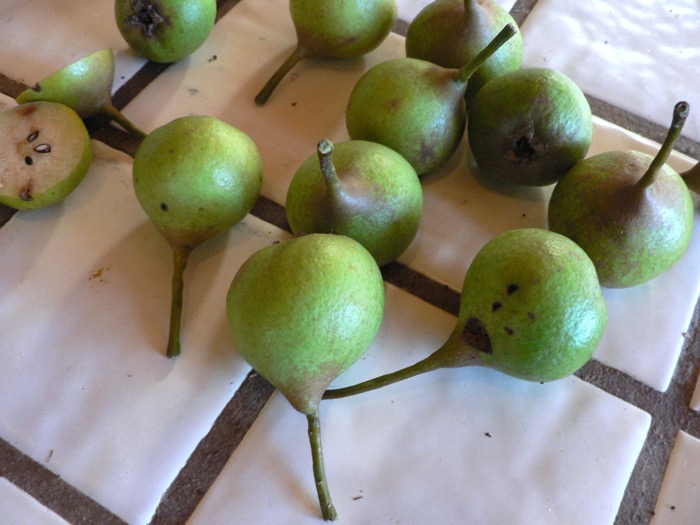
Here’s where I get confused. Those aren’t apples. Apples have a shoulder — the indent between the stem and the fruit on all apples. They’re also especially green for crab apples, which tend to be red or at least have a red “blush” when they turn ripe. These fruits are entirely green, with heavy russeting (a thick brown skin) and long stems with no shoulder.
I spent a good portion of the day googling, and I’m still not 100% sure what kind of fruit these are. They aren’t apples, and they aren’t quince (an exceptionally tart apple-like fruit). I think they may be old european wild pears. The wild pear was commonly used as a rootstock for domestic pears at the turn of the century, and it is not unusual (especially for old trees) for the grafted top of a pear to die off and the rootstock take over.
Sadly this means that these pears are probably inedible. Although they would probably make excellent pear cider. I used to make big batches of (hard) apple cider every year, so cider pears would not be unwelcome.
I put the mystery pears into the fridge; some pears need chilling to ripen. We’ll see if these soften up and turn sweeter.
23 Sep 2012
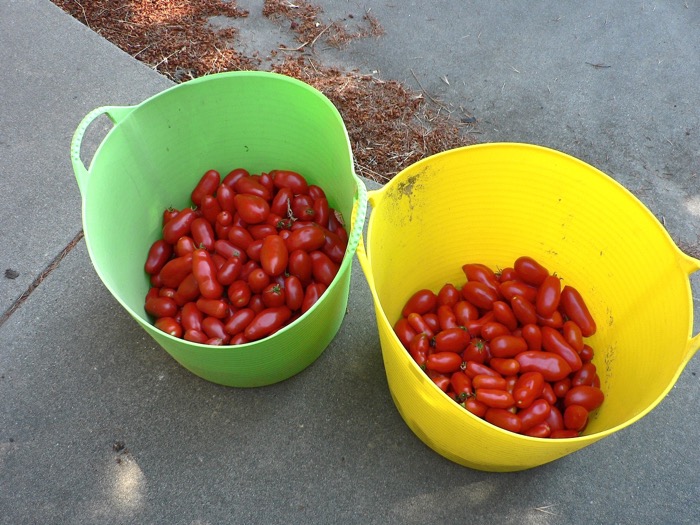
Putting tomatoes into jars. Lots of tomatoes. Lots of jars.
06 Sep 2012
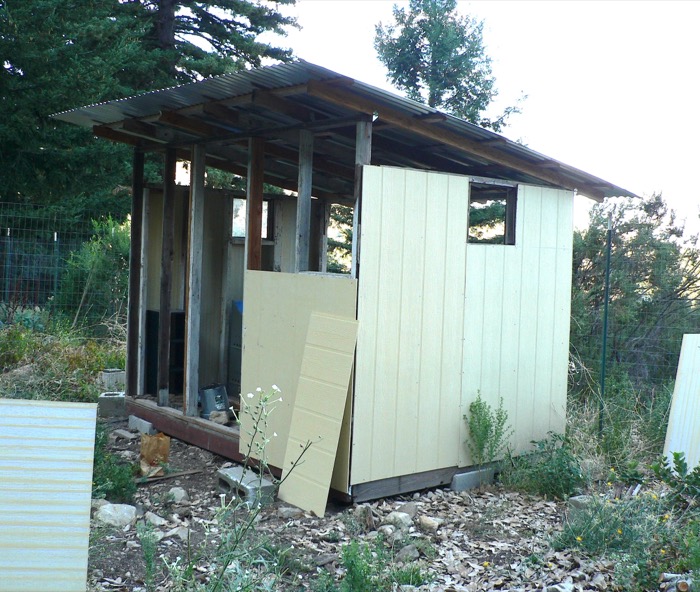
Guess what I’m doing next weekend?
05 Sep 2012

07 Feb 2012
I’ve posted a new short story over on my main site. It’s called The Deadline, and it’s a sort of dotcom horror thing. This is actually a new/old story: I started writing it in 1999 and never finished it. I recently dug it up again and realized it wasn’t that bad, although it’s kind of dated. I finished it and updated some of the more obvious anachronisms but it still has a strong 1999 feel.
I also finally got around to updating the design of my main site and putting everything back into content management. The one advantage of rebuilding wordpress a couple of times is that I’ve become very good at it. (wan smile)
19 Jan 2012
I used to count the feet.
At sundown all the chickens march into the chicken coop and hop onto the roost to put themselves to bed. I go out a little bit later with a flashlight to close the door of the chicken coop so that nothing would get at them at night. Every night I open the door and look in and count the feet to make sure that all the chickens were in there. Twenty feet; ten chickens.
And then one night I counted eighteen feet. I turned from the coop into the chicken yard with my flashlight: no chicken sleeping on top of the coop. No chicken hiding in the bushes next to the coop. No chicken wandering about in the dark looking confused, having forgotten to actually go to bed.
The light caught a bit of movement toward the back of my chicken yard. I turned the flashlight on the back fence and two glowing neon eyes stared back at me out of the darkness. Chickens do not have eyes facing forward. I took a step back, and then a step forward.
And the bobcat stopped chewing on my chicken, climbed right up the fence, jumped into the bushes and ran away.
This was only the start.
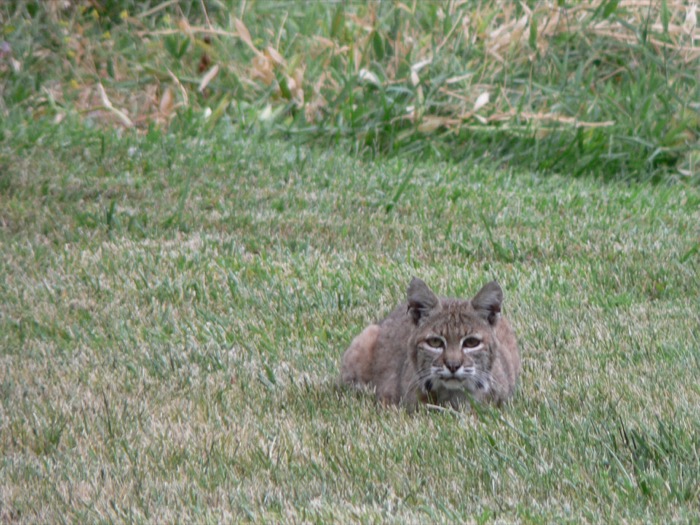
I live just outside a town called Los Gatos (the cats), originally named for the large number of bobcats in the area. We have an especially large population of bobcats that make our property home because most of our land is uncleared and we don’t own dogs. We see bobcats on the lawn, on the driveway, in the fields, and in the bushes. Bobcats are fun to watch because they behave just like very large house cats; they sleep in the sun, they wrestle like kittens, they bat pine cones around for fun. They have big tufty ears and spotty bellies. Given how cute they are it’s hard to remember that bobcats are not house cats; they are wild, and they hunt to eat.
By keeping chickens, I was putting bobcat food on a buffet and ringing the “free food” bell.
I thought that the chickens were safe. Although I had lost the occasional chicken to predators in the past, I had beefed up my chicken yard security, and it had been two years since I had lost a chicken. When the bobcat took the first bird I was momentarily struck stupid. But…I have a seven foot fence. I have a secure coop. How could this have happened? The rule I neglected to fully grasp is that a chicken yard is safe right up until the moment it isn’t, the predators have all the time in the world to look for a way in, and they will wait until the one night you forget to shut the door or the one time you have your back turned. And a fence now matter how tall is ineffective against a smart cat who can climb.
While I was wasting time dumbly trying to understand what had gone wrong two more chickens vanished, one after the other, and there was just a pile of feathers on the ground where they had been. One pile of black feathers. One pile of grey feathers. Like ashes left behind after a fire.
I put up a hot wire, a strand of electrical fencing, just short of the top of the fence. I covered the back corner of the fence with netting, where I thought the bobcat was coming in. I put the chickens to bed well before dark and let them out when the sun was well up. But all of this seemed ineffective; every few days I lost more chickens.
One afternoon in the middle of the day three chickens vanished, including my favourite, an enormous white orpington I had hatched from an egg. The white orpington had been my guard chicken, the mean one who would confront bobcats and coyotes standing just outside the fence and raise a ruckus that had all the other chickens running for the safety of the coop. My guard chicken was not mean enough. I found a big pile of white feathers and nothing else.
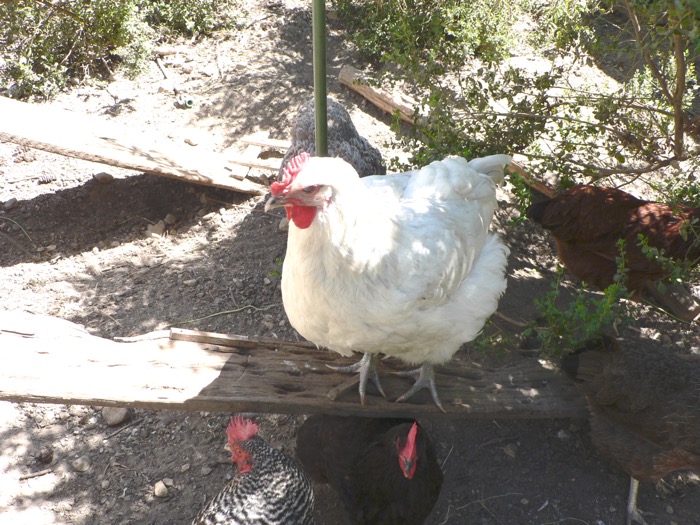
I seemed like I was fighting a losing battle; my yard was just not safe, and it was only a matter of time before the bobcats got all the chickens. I needed to do something and fast if I wanted to keep any chickens at all.
But I was too slow. Only a few days later I went out to the coop at dusk and there were no feet to count. I found more piles of feathers and two dead chickens. So that’s it, I thought, as I trudged back into the house, depressed. I’ve lost. It’s over. The bobcats had taken all of my chickens, wiped me out, in less than a week.
The next morning as I was looking out the kitchen window I saw movement in the chicken yard. Curiously, I went out into the garden, and froze in the middle of the path. There were three bobcats in the chicken yard — one large parent and two smaller half-grown bobcat kittens. They had come back for the last of the dead chickens.
“Eric!” I rushed back into the house. “Bobcats! In the yard!” Eric came out of the house to help; I turned on the garden hose. We had talked on and off about what to do if we ever actually caught the bobcats in the act. We didn’t want to shoot the bobcats and had joked that maybe turning the hose on them would scare them away. This was our last chance.
Eric cornered the larger parent bobcat in the back of the yard, but it went up and over the fence before he could get it. The two smaller cats were not as smart, and both of them got stuck in the narrow space behind the new coop and the fence. I turned the hose on “jet” and unleashed a stream of water. Wet, and frightened, one cat managed to climb the fence and escape, but I cornered the remaining one with the hose. It climbed the fence but then stayed perched on the top, growling at me as I dosed it in the face over and over again, hoping it wouldn’t decide to lunge at me over the fence in a panic.
The cat seemed to be stuck there on top of the fence, miserable, angry, soaked. I turned off the hose. Why hadn’t it hopped over? Why was it just sitting there?
“Turn off the hot wire,” I called to Eric, who had been chasing bobcats on the outside of the fence. Once the power was cut the cat finally dropped off the top of the fence into the bushes. The fence had been zapping the terrified animal at the same time I was hosing it down.
I haven’t seen any bobcats by the chicken yard for a long time now, but I suspect that is more because there are no chickens left to eat rather than because of our ninja bobcat-frightening skills.
The plan now is to rebuild the chicken yard with a stronger fence and with a roof on it. The yard will become an impenetrable chicken fortress against any known predator in the area. Given my current rate of progress on the new chicken coop this should only take four or five years, tops!






